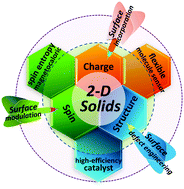Surface chemical-modification for engineering the intrinsic physical properties of inorganic two-dimensional nanomaterials
Abstract
Two-dimensional (2D) nanomaterials, especially the inorganic ultrathin nanosheets with single or few-atomic layers, have been extensively studied due to their special structures and rich physical properties coming from the quantum confinement of electrons. With atomic-scale thickness, 2D nanomaterials have an extremely high specific surface area enabling their surface phase to be as important as bulk counterparts, and therefore provide an alternative way of modifying the surface phase for engineering the intrinsic physical properties of inorganic 2D nanomaterials. In this review, we focus on recent research concerning surface chemical modification strategies to effectively engineer the intrinsic physical properties of inorganic 2D nanomaterials. We highlight the newly developed regulation strategies of surface incorporation, defect engineering, and structure modulation of inorganic 2D nanomaterials, which respectively influence the intrinsic conductivity, band structure, and magnetism while maintaining the primary 2D freestanding structures that are vital for 2D based ultrasensitive electronic response, enhanced catalytic and magnetocaloric capabilities.


 Please wait while we load your content...
Please wait while we load your content...